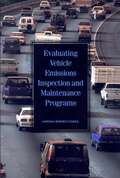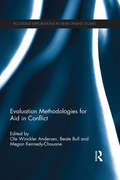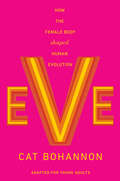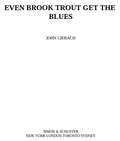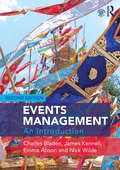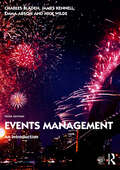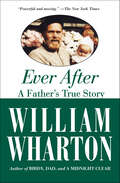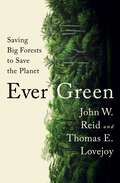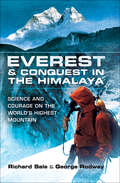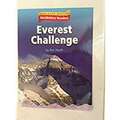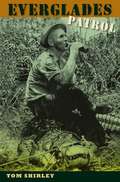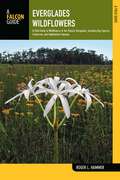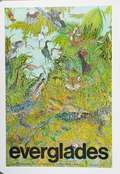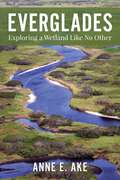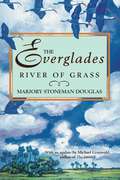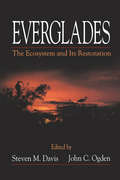- Table View
- List View
Evaluating Sustainable Food System Innovations: A Global Toolkit for Cities (Routledge Studies in Food, Society and the Environment)
by Alison Blay-Palmer Élodie Valette Amanda Di Battista Beatrice Intoppa Ophélie Roudelle Géraldine ChaboudThis book presents URBAL, an approach that applies impact pathway mapping to understand how food system innovations in cities, and their territories, change and impact food system sustainability. Around the world, people are finding innovative ways to make their food systems more sustainable. However, documenting and understanding how these innovations impact the sustainability of food system can be a challenge. The Urban Driven Innovations for Sustainable Food Systems (URBAL) methodology responds to these constraints by providing innovations with a simple, open-source, resource-efficient tool that is easily appropriated and adaptable to different contexts. URBAL is designed to respond to the demands of field stakeholders, whether public or private, to accompany and guide them in their actions and decision-making with regard to sustainability objectives. This book presents this qualitative and participatory impact assessment method of food innovations and applies it to several cases of food innovation around the world, including the impact of agricultural districts in Milan, chefs and gastronomy in Brasilia, e-commerce in Vietnam, eco-friendly farm systems in Berlin and The Nourish to Flourish governance process in Cape Town. The book demonstrates how food innovations can impact different dimensions of sustainability, positively and negatively, and identify the elements that facilitate or hinder these impacts. The volume reflects on how to strengthen the capacity of these stakeholders to disseminate their innovations on other scales to contribute to the transition towards more sustainable food systems. This book will be of great interest to students and scholars working on sustainable food systems, urban food, food innovation and impact assessment, as well as policymakers, practitioners and funders interested in these areas.
Evaluating Vehicle Emissions Inspection and Maintenance Programs
by Committee on Vehicle Emission Inspection Maintenance ProgramsEmissions inspection and maintenance (I/M) programs subject vehicles to periodic inspections of their emission control systems. Despite widespread use of these programs in air-quality management, policy makers and the public have found a number of problems associated with them. Prominent among these issues is the perception that emissions benefits and other impacts of I/M programs have not been evaluated adequately. Evaluating Vehicle Emissions Inspection and Maintenance Programsassesses the effectiveness of these programs for reducing mobile source emissions. In this report, the committee evaluates the differences in the characteristics of motor vehicle emissions in areas with and without I/M programs, identifies criteria and methodologies for their evaluation, and recommends improvements to the programs. Most useful of all, this book will help summarize the observed benefits of these programs and how they can be redirected in the future to increase their effectiveness.
Evaluation Methodologies for Aid in Conflict (Routledge Explorations in Development Studies)
by Ole Winckler Andersen Beate Bull Megan Kennedy-ChouaneKnowledge and rigorous evidence around the role of external development partners in situations of conflict and fragility is still lacking. There is little accountability for the billions in aid being spent in places like Afghanistan, Iraq and the Democratic Republic of Congo. This book analyses evaluation theory and practice in order to help fill this knowledge gap and advocates a realistic and rigorous approach to evaluating international engagement. Through a series of case studies, this book highlights both the promise, and potential pitfalls, of taking a more evaluative approach to understanding aid in conflict regions. These illustrate the methodological and analytical approach taken by researchers working to understand the results and effectiveness of conflict prevention and peacebuilding support. While well-grounded in current theoretical and methodological debates, the book provides valuable practical information by examining how and why different choices were made in the context of each evaluation. The book shows what future steps may be envisaged to further strengthen evaluations of support for conflict prevention and peacebuilding. The analysis draws on a wealth of perspectives and voices to provide researchers and students in development studies and conflict and peace studies as well as development evaluators with a deep and broad understanding of evaluation methods and approaches.
Evaluation of Safety and Environmental Metrics for Potential Application at Chemical Agent Disposal Facilities
by National Research Council of the National AcademiesBy the end of 2009, more than 60 percent of the global chemical weapons stockpile declared by signatories to the Chemical Weapons Convention will have been destroyed, and of the 184 signatories, only three countries will possess chemical weapons-the United States, Russia, and Libya. In the United States, destruction of the chemical weapons stockpile began in 1990, when Congress mandated that the Army and its contractors destroy the stockpile while ensuring maximum safety for workers, the public, and the environment. The destruction program has proceeded without serious exposure of any worker or member of the public to chemical agents, and risk to the public from a storage incident involving the aging stockpile has been reduced by more than 90 percent from what it was at the time destruction began on Johnston Island and in the continental United States. At this time, safety at chemical agent disposal facilities is far better than the national average for all industries. Even so, the Army and its contractors are desirous of further improvement. To this end, the Chemical Materials Agency (CMA) asked the NRC to assist by reviewing CMA's existing safety and environmental metrics and making recommendations on which additional metrics might be developed to further improve its safety and environmental programs.
Evaluation of the U.S. Department of Energy's: Alternatives for the Removal and Disposition of Molten Salt Reactor Experiment Fluoride Salts
by Molten Salt Panel of the Committee on Remediation of Buried Tank WastesThis book discusses the technical alternatives for cleanup of radioactive fluoride salts that were the fuel for the Molten Salt Reactor Experiment, a novel nuclear reactor design that was tested in the 1960s at the Oak Ridge National Laboratory in Tennessee. These fluoride salts pose an unusual cleanup challenge. The book discusses alternatives for processing and removing the salts based on present knowledge of fluoride salt chemistry and nuclear reactions of the radioactive constituents.
Eve (Adapted for Young Adults): How the Female Body Shaped Human Evolution
by Cat BohannonThe groundbreaking New York Times bestseller is now adapted for young adults! This is the 200-million-year story of how the female body gave rise to the human species and forever shaped life on Earth and what that means for us in the future.Why do women live longer than men? Why do girls score better at every academic subject than boys until puberty, when suddenly their scores plummet? Is the female brain "wired differently?" These questions and common debates around scientific claims are thoughtfully examined in this adaptation perfect for young people.This brand-new adaptation is a friendly, funny, and engaging read. It explores teen related topics such as mental health and the biology behind it, including insights on how adolescent brains are going through all kinds of changes, and shifting hormones. Author Cat Bohannon explains the roots of sexism and shows how, though it may have even served some evolutionary purpose long ago, it no longer serves us today, and it&’s high time we leave it in the past.Filled with amazing stories of both past and present, Eve will delight any young reader looking to understand the body—its amazing history, its wondrous capability, its oddities and mysteries, and its relevance to so many issues captivating contemporary thought and discussion.
Even Brook Trout Get The Blues
by John GierachFrom his reminiscences about learning to fish to a lyrical piece about fishing during a late spring snow to a wry, though compassionate, look at the hard life of a brook trout, Gierach provides entertainment for fly-fishers and literature lovers alike.
Even So
by Charles Boardman HawesCharles Boardman Hawes is the Newberry Medal award-winning author of 'The Dark Frigate'. "Donald Hastings followed the sea. Holiest, impetuous, young, as were so many of those sea captains in that golden era of the early nineteenth century, he left but one shadow on his memory—perhaps not altogether a shadow. Therein lies the story.
Events Management
by Emma Abson Nick Wilde James Kennell Charles BladenContemporary events management is a diverse and challenging field. This major new introductory textbook is the first to fully explore the multi-disciplinary nature of events management and to provide all the practical skills and professional knowledge students need to succeed in the events industry. The book covers every type of event studied on an Events Management course, including sports, music, the arts, corporate events, tourism, and the public and voluntary sectors. It introduces the key issues facing the contemporary events industry, from health, safety and risk management to sustainability to developing a market-oriented business, with every topic brought to life through case-studies, personal biographies and examples of best practice. Written by a team of authors with many years of industry experience, it introduces the practical skills required in every core area of events management, including marketing, finance, project management, strategy, operations, event design and human resources. A companion website for the book includes a dazzling array of additional features, including self-test questions, audio interviews with key industry figures, additional case-studies and PowerPoint slides for each chapter. Events Management: An Introduction is the essential course text for any events management program.
Events Management: An Introduction
by Emma Abson Nick Wilde James Kennell Charles BladenContemporary events management is a diverse and challenging field. This introductory textbook fully explores the multidisciplinary nature of events management and provides the student with all the practical skills and professional knowledge they need in order to succeed in the events industry. It introduces every core functional area of events management, such as marketing, finance, project management, strategy, operations, event design and human resources, in a vast array of different event settings from sport to political events. This new edition has been updated to include: • New and updated content on developments in technology, risk management and event volunteering. • New and updated case studies that include emerging economies. • New industry voices by international practitioners. Every topic is brought to life through vivid case studies, personal biographies and examples of best practice from the real world of events management. Written by a team of authors with many years’ experience of working in the events industry, Events Management: An Introduction is the essential course text for any events management programme.
Events Management: An Introduction
by Emma Abson Nick Wilde James Kennell Charles BladenContemporary events management is a diverse and challenging field. This introductory textbook fully explores the multidisciplinary nature of events management and provides the student with all the practical skills and professional knowledge they need to succeed in the events industry. It introduces every core functional area of events management, such as marketing, finance, project management, strategy, operations, event design and human resources, in a vast array of different event settings from sport to political events. This new edition has been updated to include: New and updated content on technological developments in events such as virtual/hybrid events, artificial intelligence, virtual/augmented reality, holograms in music events, software for event planning and projection mapping. New content on eSports, the sustainability sector, employability skills, policy changes, diversity and inclusion, ethics and responsibility in events, and contemporary event safety and security issues including the threat of terrorism. New and updated case studies that cover a wider range of regions. A fully updated and extended companion website that includes web and video links, quizzes and a case study archive for students, as well as PowerPoint slides for instructors and a brand-new instructor manual full of teaching strategy ideas. Every topic is brought to life through vivid case studies, personal biographies and examples of best practice from the real world of events management. Written by a team of authors with many years’ experience of working in the events industry, Events Management: An Introduction is the essential course text for any events management programme.
Events of Art and Education in Post-climate Times (Routledge Studies in Sustainability)
by Carl Anders SäfströmThis book concerns the urgency of thinking and acting in response to climate change through art and education. While both fields are often connected through disciplinary dialogues, climate change prompts a greater need to unite artists and educators around common environmental problems and goals.By staging transcritical engagements, this book draws out common and uncommon disciplinary perspectives that can generate new ways of thinking, living, and doing in the Anthropocene. Ideas around courage, resilience, life, and death emerge. An expression of active, non-violent resistance to the ongoing destruction of our planet, this book supports imaginative action, popular sovereignty, and the courage to live well within the challenges of our era. Engaging artists’ and educators’ questions, it maps significant differences and potential intersections for further enquiry.Events of Art and Education in Post-climate Times will be helpful for students studying art, education, environment, sustainability, and climate change. It will also interest researchers, practising artists, and teachers in these disciplines by being at the forefront of current discussions in both fields.
Eventscapes: Transforming Place, Space and Experiences
by Graham BrownEventscapes: Transforming Place, Space and Experiences directly examines the interrelation between events’ simultaneous dependence on and transformation of the places in which they are held. This event–environment nexus is analysed through a variety of international case studies including different kinds of well-known sporting and cultural events such as Vivid Sydney, the Vancouver 2010 Winter Olympics and the Tour Down Under international cycle race, among others. Chapters focusing on visual design explore the opportunities, at different spatial scales, to develop an event ‘look’ and the ways in which an event experience can be enhanced through connecting and engaging with the local culture and community. As well as the planning and management of events, the book draws on event experience, dramaturgically examining the roles played by authors, actors and the audience, and emphasises the participation of multiple groups in the co-creation of event experiences. This will be invaluable reading for those studying events and the environment. Adopting a multidisciplinary approach, it also draws on geography, urban and cultural studies, image studies, architecture and design, environmental psychology, and event management, and will be of use to a broad academic audience.
Ever After: A Father's True Story
by William WhartonIn August of 1988, heavy black smoke engulfed an Oregon highway, causing a massive 23-car pileup that claimed the lives of novelist William Wharton's 36-year-old daughter, her husband, and their two infant daughters. They'd been victims of field burning, a routine agricultural practice, and were burned alive in their van.How could such a thing happen? And how could a father come to terms with such a loss? Ever After, Wharton's first memoir, is his search for answers to these questions, written with the inspired simplicity that won him great acclaim for his novels.
Ever Green: Saving Big Forests to Save the Planet
by Thomas E. Lovejoy John W. ReidClear, provocative, and persuasive, Ever Green is an inspiring call to action to conserve Earth’s irreplaceable wild woods, counteract climate change, and save the planet. Five stunningly large forests remain on Earth: the Taiga, extending from the Pacific Ocean across all of Russia and far-northern Europe; the North American boreal, ranging from Alaska’s Bering seacoast to Canada’s Atlantic shore; the Amazon, covering almost the entirety of South America’s bulge; the Congo, occupying parts of six nations in Africa’s wet equatorial middle; and the island forest of New Guinea, twice the size of California. These megaforests are vital to preserving global biodiversity, thousands of cultures, and a stable climate, as economist John W. Reid and celebrated biologist Thomas E. Lovejoy argue convincingly in Ever Green. Megaforests serve an essential role in decarbonizing the atmosphere—the boreal alone holds 1.8 trillion metric tons of carbon in its deep soils and peat layers, 190 years’ worth of global emissions at 2019 levels—and saving them is the most immediate and affordable large-scale solution to our planet’s most formidable ongoing crisis. Reid and Lovejoy offer practical solutions to address the biggest challenges these forests face, from vastly expanding protected areas, to supporting Indigenous forest stewards, to planning smarter road networks. In gorgeous prose that evokes the majesty of these ancient forests along with the people and animals who inhabit them, Reid and Lovejoy take us on an exhilarating global journey.
Everest & Conquest in the Himalaya: Science and Courage on the World's Highest Mountain
by Richard Sale George RodwayA history of those who have scaled Mount Everest—and the advances in mountaineering over a century. At one time, the summits of the world&’s highest peaks—Everest included—were beyond reach. Pioneering attempts to overcome the dangers of climbing at extremely high altitudes ended in failure, sometimes with disastrous consequences. Yet today, high-altitude ascents are frequent, almost commonplace. Everest can be conquered by relatively inexperienced mountaineers, and their exploits barely merit media attention—unless they go fatally wrong. This dramatic history of Everest climbs describes in vivid detail the struggle to conquer the mountain and the advances in scientific knowledge that made the conquest possible. It also offers compelling insight into the science of mountaineering—as well as the physical and psychological challenges faced by individuals who choose to test themselves in some of the harshest conditions on earth.
Everest 1953: The Epic Story of the First Ascent
by Mick ConefreyOn the morning of 2 June 1953, the day of Queen Elizabeth's coronation, the first news broke that Everest had finally been conquered. Drawing on first-hand interviews and unprecedented access to archives, this is a ground-breaking new account of that extraordinary first ascent. Revealing that what has gone down in history as a supremely well-planned expedition was actually beset by crisis and controversy, Everest 1953 recounts a bygone age of self-sacrifice and heroism, using letters and personal diaries to reveal the immense stress and heartache the climbers often hid from their fellow team members. Charting how the ascent affected the original team in subsequent years and detailing its immense cultural impact today, Everest 1953 is the perfect book to commemorate this remarkable feat of the human will.
Everest Challenge (Houghton Mifflin Harcourt Vocabulary Readers #Leveled Reader: Level: 5, Theme: 2.3)
by Ben HeathA brief introduction to the mountain climber Tom Whittaker.
Everglades Adventure
by Stephen W. MeaderToby Morgan was sixteen when his doctor father moved the family from New Jersey to Fort Dallas-now known as Miami-just after the Civil War. Florida then was an unexplored tropical wilderness that would have delighted the heart of an active boy-and Toby was no exception. Hunting, fishing, and cruising in his canoe through the watery channels of the Everglades, Toby soon came to know the birds and animals that abound there, as well as the ruthless plume hunters. He also discovered a forgotten tribe of Indians deep in the swampland. One day, in a dangerous encounter with an alligator, Toby's life was saved by Miki-loko, son of the Caloosa chief, and they became close friends. Later, when Professor Evans, a naturalist, arrived to photograph Florida wild life, Toby was well qualified to act as guide for him and his tomboy daughter, Sue. Through a swift and unexpected turn of events, the story builds to an exciting climax, and in the end Toby is launched on a fascinating scientific career. As a writer of thrilling adventure tales for teen-agers, Stephen Meader has few equals, and, in his new book, he has not only told a story of action and suspense, but has caught the vivid color of a picturesque era with authenticity and rare skill.
Everglades Patrol
by Tom ShirleyAs law enforcement officer and game manager for the Florida Game and Fresh Water Fish Commission, Lt. Tom Shirley was the law in one of the last true frontiers in the nation--the Florida Everglades.In Everglades Patrol, Shirley shares the stories from his beat--an ecosystem larger than the state of Rhode Island. His vivid narrative includes dangerous tales of hunting down rogue gladesmen and gators and airboat chases through the wetlands in search of illegal hunters and moonshiners.During his thirty-year career (1955-1985), Shirley saw the Glades go from frontier wilderness to "ruination" at the hands of the Army Corps of Engineers. He watched as dikes cut off the water flow and controlled floods submerged islands that had supported man and animals for 3,000 years, killing much of the wildlife he was sworn to protect.
Everglades Wildflowers: A Field Guide to Wildflowers of the Historic Everglades, including Big Cypress, Corkscrew, and Fakahatchee Swamps (Wildflowers in the National Parks Series)
by Roger L. HammerThe Everglades region is a mosaic of interconnected ecosystems where a slight elevation change can lead you from dry, rocky pinelands and shady hardwood hammocks to flooded grassy prairies and deep, mysterious swamps. Fascinating wildflowers abound in every habitat. This full-color, expanded second edition contains beautiful photos, easy-to-understand descriptions, and interesting facts about 362 wildflowers that inhabit this picturesque region.
Everglades Wildguide
by Jean Craighead GeorgeHere is the story of the plants and animals of the Everglades, this country’s subtropical kingdom. Plants and animals found nowhere else in the 50 states are found here in abundance, though in an increasingly perilous state. In this handbook, first published in 1972, author and researcher Jean Craighead George brings to the telling of this story long years of study and understanding. Checklists and glossaries at the back buttress her account of the natural history of this national park.
Everglades: Exploring a Wetland Like No Other
by Anne AkeThe Everglades is an environment like no other, spanning from coast to coast across South Florida. With unique creatures like the American Alligator to beautiful birds such as the Great Blue Herons, lovers of wildlife and nature are sure to find enjoyment out on an airboat, paddling their kayak, or walking the boardwalks.In Everglades: Exploring a Wetland Like No Other, author Anne E. Ake discusses crucial facts, figures, and details about the glades while also enlightening readers on key information regarding conservation and restoration. This book covers important topics such asThe prevalent water level issues the glades face Invasive species such as the Burmese PythonUp-to-date data on wildlife and environmental factorsCalls to action for conservation and restoration effortsWith over 90 color photos from a variety of stunning wildlife photographers including the author herself, readers new to the Everglades and seasoned glades visitors alike will find beauty and inspiration from this book.
Everglades: River of Grass
by Marjory Stoneman DouglasBefore 1947, when Marjory Stoneman Douglas named The Everglades a "river of grass," most people considered the area worthless. She brought the world's attention to the need to preserve The Everglades. In the Afterword, Michael Grunwald tells us what has happened to them since then. Grunwald points out that in 1947 the government was in the midst of establishing the Everglades National Park and turning loose the Army Corps of Engineers to control floods--both of which seemed like saviors for the Glades. But neither turned out to be the answer. Working from the research he did for his book, The Swamp, Grunwald offers an account of what went wrong and the many attempts to fix it, beginning with Save Our Everglades, which Douglas declared was "not nearly enough." Grunwald then lays out the intricacies (and inanities) of the more recent and ongoing CERP, the hugely expensive Comprehensive Everglades Restoration Plan.
Everglades: The Ecosystem and Its Restoration
by Steve Davis John C. OgdenThe 31 chapters provide a wealth of previously unpublished information, plus topic syntheses, for a wide range of ecological parameters. These include the physical driving forces that created and continue to shape the Everglades and patterns and processes of its flora and fauna. The book summarizes recent studies of the region's vegetation, alligat

